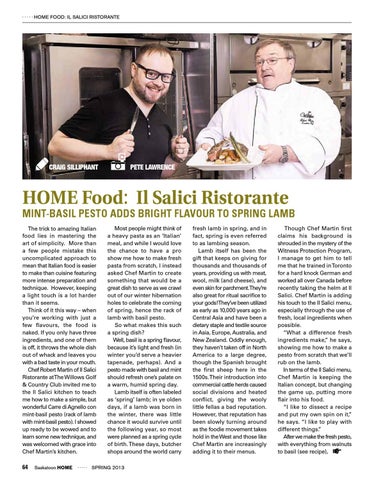. . . . . HOME FOOD: IL SALICI RISTORANTE
CRAIG SILLIPHANT
PETE LAWRENCE
HOME Food: Il Salici Ristorante
MINT-BASIL PESTO ADDS BRIGHT FLAVOUR TO SPRING LAMB The trick to amazing Italian food lies in mastering the art of simplicity. More than a few people mistake this uncomplicated approach to mean that Italian food is easier to make than cuisine featuring more intense preparation and technique. However, keeping a light touch is a lot harder than it seems. Think of it this way – when you’re working with just a few flavours, the food is naked. If you only have three ingredients, and one of them is off, it throws the whole dish out of whack and leaves you with a bad taste in your mouth. Chef Robert Martin of Il Salici Ristorante at The Willows Golf & Country Club invited me to the Il Salici kitchen to teach me how to make a simple, but wonderful Carre di Agnello con mint-basil pesto (rack of lamb with mint-basil pesto). I showed up ready to be wowed and to learn some new technique, and was welcomed with grace into Chef Martin’s kitchen.
64
Saskatoon HOME
.....
Most people might think of a heavy pasta as an ‘Italian’ meal, and while I would love the chance to have a pro show me how to make fresh pasta from scratch, I instead asked Chef Martin to create something that would be a great dish to serve as we crawl out of our winter hibernation holes to celebrate the coming of spring, hence the rack of lamb with basil pesto. So what makes this such a spring dish? Well, basil is a spring flavour, because it’s light and fresh (in winter you’d serve a heavier tapenade, perhaps). And a pesto made with basil and mint should refresh one’s palate on a warm, humid spring day. Lamb itself is often labeled as ‘spring’ lamb; in ye olden days, if a lamb was born in the winter, there was little chance it would survive until the following year, so most were planned as a spring cycle of birth. These days, butcher shops around the world carry
SPRING 2013
fresh lamb in spring, and in fact, spring is even referred to as lambing season. Lamb itself has been the gift that keeps on giving for thousands and thousands of years, providing us with meat, wool, milk (and cheese), and even skin for parchment.They’re also great for ritual sacrifice to your gods!They’ve been utilized as early as 10,000 years ago in Central Asia and have been a dietary staple and textile source in Asia, Europe, Australia, and New Zealand. Oddly enough, they haven’t taken off in North America to a large degree, though the Spanish brought the first sheep here in the 1500s. Their introduction into commercial cattle herds caused social divisions and heated conflict, giving the wooly little fellas a bad reputation. However, that reputation has been slowly turning around as the foodie movement takes hold in the West and those like Chef Martin are increasingly adding it to their menus.
Though Chef Martin first claims his background is shrouded in the mystery of the Witness Protection Program, I manage to get him to tell me that he trained in Toronto for a hard knock German and worked all over Canada before recently taking the helm at Il Salici. Chef Martin is adding his touch to the Il Salici menu, especially through the use of fresh, local ingredients when possible. “What a difference fresh ingredients make,” he says, showing me how to make a pesto from scratch that we’ll rub on the lamb. In terms of the Il Salici menu, Chef Martin is keeping the Italian concept, but changing the game up, putting more flair into his food. “I like to dissect a recipe and put my own spin on it,” he says. “I like to play with different things.” After we make the fresh pesto, with everything from walnuts to basil (see recipe),
